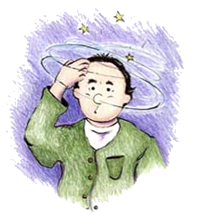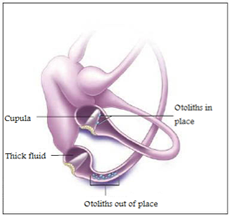Vertigo may include feelings of the “room spinning”, dizziness, nausea, vomiting and headaches.
There are many types of vertigo and it can have multiple causes. Dizziness affects more than 50% of the population over age 65 and we have seen a recent increase in the younger population. Dizziness can come from a variety of sources. It is important to consider sources of dizziness. 85% of vertigo comes from BPPV (benign paroxysmal positional vertigo). This usually makes one feel like the room is spinning when changing position (like getting out of bed). More concerning problems should be ruled out by your doctor. BPPV is resolved in 85-90% of cases in one physical therapy treatment for the inner ear. Other types of vertigo may require vestibular rehabilitation and/or referral to an ear, nose and throat doctor.
BPPV is a common type of vertigo that may be helped with treatment in physical therapy. It is caused by small calcium carbonate crystals, called otoliths that may break free from their place of origin (the cupula).
Sometimes this occurs without any reason.
The cupula is a pyramidal shaped surface that is in the vestibule which connects three semi-circular canals. These canals have a thick liquid inside which spins when your head moves in any direction. There are small hairs, called cilia, which move when this liquid moves. The loose otoliths can move and trick the hairs into sending signals that your head is moving when it is not. This usually occurs when lying down, getting up and rotating the head. It can be miserable.
Causes:
Otoliths may break free when the head is struck or moved quickly, such as with a roller coaster or a car crash.

What do we do?
We take a thorough history to determine the chances that the vertigo is coming from BPPV.
Then tests may be performed to confirm this. Then treatment is performed to spin the otoliths back into position, near the cupula so that they may reattach.
It is important that you NOT move your head quickly, or lie your head down flat for36 to 48 hours after this treatment. This is critical to allow the crystals to reattach.
Other:
Medication can be helpful in numbing the brain to the feeling of vertigo, but does not correct the problem. The longer this problem goes on, the more difficult it can be to treat.
In Meniere’s disease, a different problem causing vertigo, the inner ear fluid (endolymph) pressure is increased. We do not correct this problem, but would refer you to another professional for treatment.
Cervicogenic dizziness comes from the neck. It can include symptoms such as lightheadedness, nausea, headache (especially in the back of the head and behind the eye), dizziness, fatigue, foggy, neck pain and stiffness, and feeling off balance. Less frequently occurring are visual disturbances, sweating, ringing in the ears, problems with swallowing, TMJ (jaw) pain, arm pain or burning. These signs can also be related to other problems, so discussing this with your doctor is important.
Cervicogenic dizziness is affected by neck positioning. Symptoms tend to be worse in positions that compromise the neck, such as using a computer, driving, watching TV, using a smart phone, reading and being bent forward. This problem tends to build up over time. The great news is that there is treatment. Correcting posture and building up the right muscles in the neck are part of working toward a long term fix. Heat, massage techniques (such as trigger point therapy), electrical stimulation, mobilization and traction have been shown to be helpful as well.
The most common cause of this is long-term poor posture. However, trauma, such as a fall or car accident, can also be related to the onset of dizziness. Usually, the dizziness comes and goes and is combined with a loss of range of motion in the neck.
A thorough evaluation is the best way to determine what type of dizziness or vertigo is occurring. There is no specific test for cervicogenic dizziness. It does not show up on x-ray or MRI. Therefore, it is important to first ruling out other sources of dizziness as the primary cause. For this reason it is very important to understand the history, perform a physical examination, and perform vestibular function tests to get a better understanding of the underlying condition.
McVay Physical Therapy treats cervicogenic dizziness, BPPV, vestibular rehabilitation including desensitization, balance and gait training. Treatment is individualized for each person and is preceded by a thorough evaluation.



Recent Comments